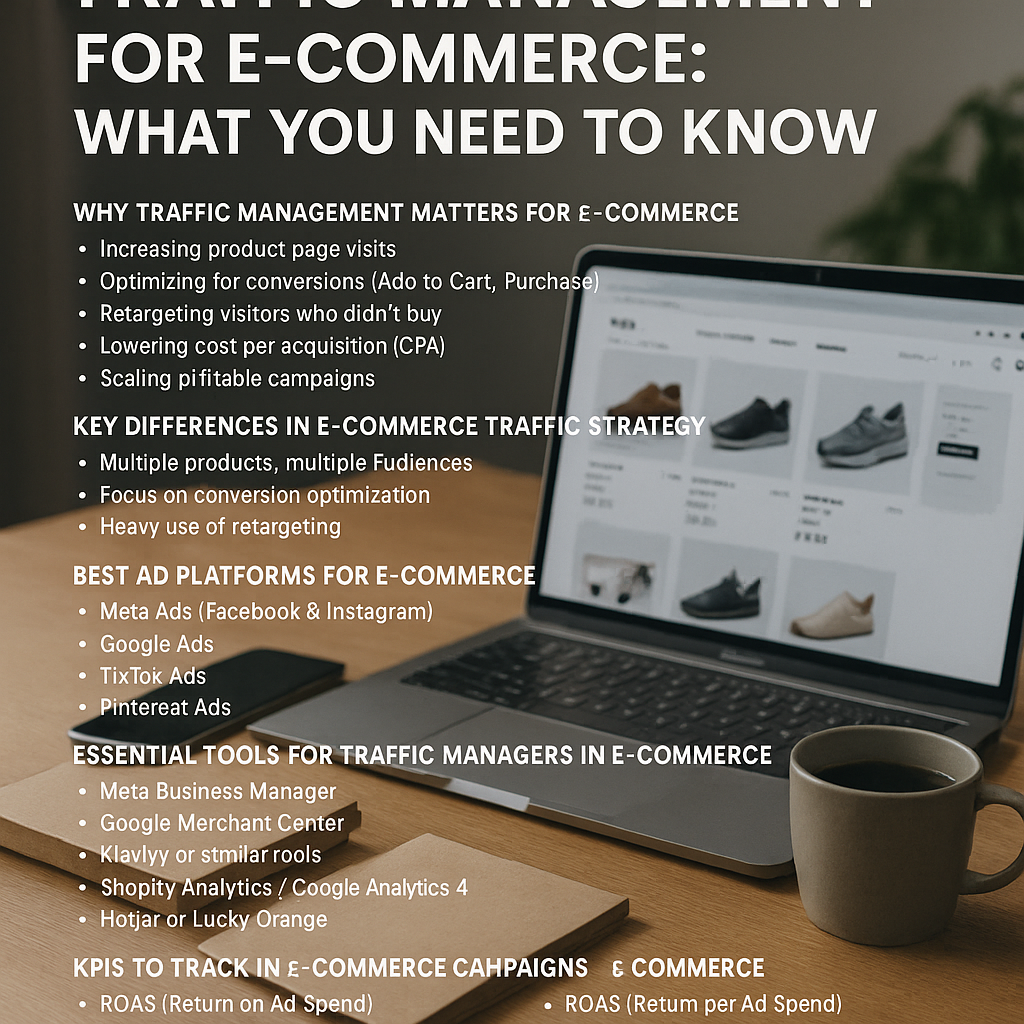E-commerce is one of the fastest-growing industries in the world—and with growth comes competition. That’s why traffic management is a critical part of every successful online store. Without targeted, optimized, and scalable paid traffic, even the best products can go unnoticed.
In this article, you’ll learn how traffic management works specifically for e-commerce businesses, what makes it different from other niches, and how to structure campaigns that actually generate sales.
Why Traffic Management Matters for E-commerce
In e-commerce, traffic management isn’t just about bringing people to the website—it’s about bringing the right people at the right time, guiding them to the product they’re most likely to buy, and ensuring they complete the purchase.
An e-commerce traffic manager focuses on:
- Increasing product page visits
- Optimizing for conversions (Add to Cart, Purchase)
- Retargeting visitors who didn’t buy
- Lowering cost per acquisition (CPA)
- Scaling profitable campaigns
Done right, traffic management can take an e-commerce business from a few daily sales to thousands per month.
Key Differences in E-commerce Traffic Strategy
1. Multiple Products, Multiple Audiences
Unlike a service-based business with one offer, e-commerce stores usually have dozens or hundreds of products. This means managing:
- Product catalogs
- Shopping feeds
- Dynamic retargeting
- Different creatives for different segments
A traffic manager must organize campaigns around product categories, bestsellers, seasonal offers, and customer interests.
2. Focus on Conversion Optimization
You can drive all the traffic in the world, but if your store doesn’t convert, it’s money wasted. That’s why e-commerce traffic managers often help improve:
- Product page layout
- Mobile speed and usability
- Checkout flow
- Trust elements (reviews, shipping info, guarantees)
3. Heavy Use of Retargeting
Most customers won’t buy on their first visit. That’s where retargeting becomes essential—showing ads to users who:
- Viewed products but didn’t buy
- Added to cart but abandoned checkout
- Bought once (upsell/cross-sell opportunities)
Platforms like Facebook Ads and Google Ads allow advanced retargeting using product-specific dynamic ads.
Best Ad Platforms for E-commerce
The most effective ad platforms for e-commerce include:
Meta Ads (Facebook & Instagram)
- Dynamic Product Ads (DPA) for catalog retargeting
- Lookalike audiences based on buyers
- Great for cold and warm traffic
- Excellent for storytelling via Reels and Stories
Google Ads
- Google Shopping campaigns
- Search ads for branded keywords and high-intent searches
- YouTube ads for product demos
- Smart campaigns with automatic bidding
TikTok Ads
- UGC-style videos that feel native
- Excellent for impulse buys and lifestyle brands
- Requires creative video production but has low CPM
Pinterest Ads
- Great for DIY, fashion, home decor, and wellness
- Long shelf life and strong buyer intent
- Works best with high-quality visuals
Each platform serves a different stage of the customer journey. The best traffic managers combine them strategically.
Campaign Structures That Work
There’s no universal blueprint, but here’s a proven campaign structure:
1. Cold Traffic Campaigns
Reach new people who have never interacted with your brand.
- Use interest-based or lookalike audiences
- Showcase bestsellers or current promos
- Focus on awareness and clicks
2. Warm Traffic Campaigns
Engage people who visited your website or interacted with your content.
- Use retargeting audiences
- Show product benefits or limited-time offers
- Encourage add to cart or view more
3. Hot Traffic Campaigns
Target cart abandoners or people very close to buying.
- Use urgency and scarcity (“Only 3 left”)
- Include discount codes or free shipping
- Push them to complete the checkout
4. Repeat Buyer Campaigns
Encourage existing customers to buy again.
- Upsell related items
- Promote bundles or new arrivals
- Offer loyalty discounts
This full-funnel approach maximizes return on ad spend (ROAS) and builds customer lifetime value (CLV).
Essential Tools for Traffic Managers in E-commerce
To do the job properly, traffic managers use:
- Meta Business Manager: catalog setup, events tracking, ads
- Google Merchant Center: product feed syncing with Google Ads
- Klaviyo or similar tools: for email retargeting
- Shopify Analytics / Google Analytics 4: conversion tracking
- Hotjar or Lucky Orange: session recording to see how users behave
Bonus tools: Canva for creative design, Google Tag Manager for tracking, and platforms like Notion or Trello for campaign organization.
KPIs to Track in E-commerce Campaigns
Your success will be measured by numbers. Important KPIs include:
- ROAS (Return on Ad Spend): Total revenue / total ad spend
- CPA (Cost per Acquisition): Ad spend per purchase
- CTR (Click-Through Rate): Clicks divided by impressions
- AOV (Average Order Value): Revenue per purchase
- CVR (Conversion Rate): Purchases divided by clicks
- CLV (Customer Lifetime Value): Average revenue per customer over time
As you optimize, your goal is to lower CPA and increase ROAS without sacrificing ad volume.
Common Mistakes in E-commerce Traffic Management
- Sending traffic to the homepage instead of specific products
- Ignoring mobile optimization
- Not segmenting audiences (e.g., cold vs warm)
- Running campaigns without retargeting
- Overcomplicating offers with too many variations
- Not testing enough creatives or product angles
Final Thoughts: Drive the Right Traffic, Not Just More
E-commerce traffic management isn’t just about increasing visitors—it’s about increasing the right kind of visitors. As a traffic manager, your job is to connect product demand with customer intent, and optimize every step from click to checkout.
Start with one product or campaign, master the funnel, track your numbers, and grow from there. With skill, testing, and consistency, you can build profitable, scalable traffic systems that fuel any online store.

